#Anpo protests
Text
1960-Michiko Kanba (樺美智子)
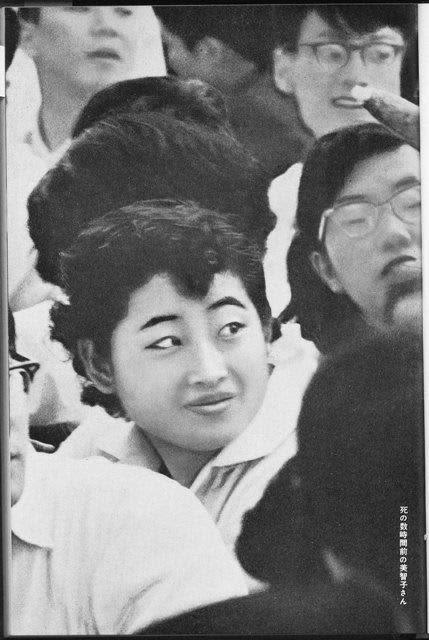
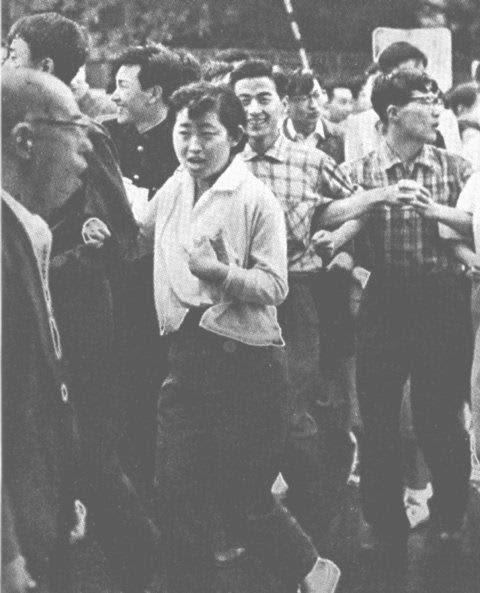

Michiko Kanba (樺 美智子, Kanba Michiko, November 8, 1937 – June 15, 1960) was a Japanese communist, University of Tokyo undergraduate, and a Zengakuren activist. She died in clashes between demonstrators and police at the South Gate of the National Diet Building in central Tokyo at the climax of the 1960 Anpo Protests against the US-Japan Security Treaty.
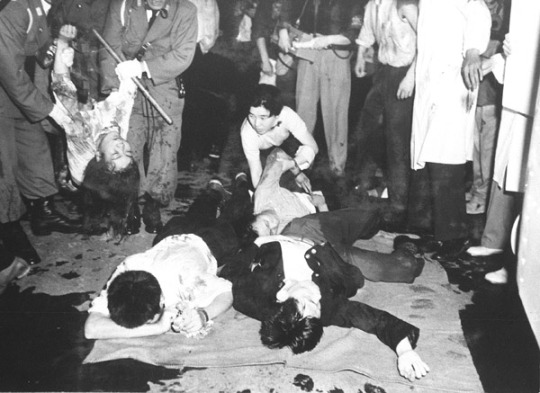
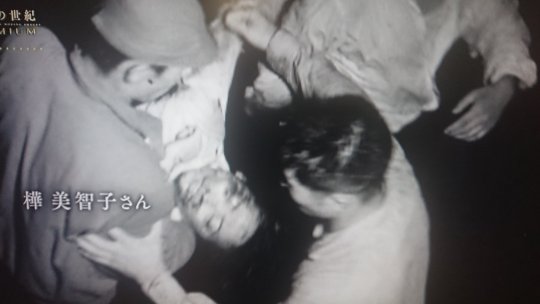
Kanba's death was widely covered at the time, and is seen as a symbol of the 1960 mass protests against the revised Treaty of Mutual Cooperation and Security Between the United States and Japan. Historian Nick Kapur argues that nationwide shock at Kanba's death helped force the resignation of Prime Minister Nobusuke Kishi and the cancellation of a planned visit to Japan by U.S. President Dwight D. Eisenhower.[8] Kapur says Kanba's death was viewed as a "triple tragedy," first because she was so young, second because she was a student at Japan's most elite university, and third, because she was a woman, at a time when it was still novel for women to participate on the front lines of street protests.

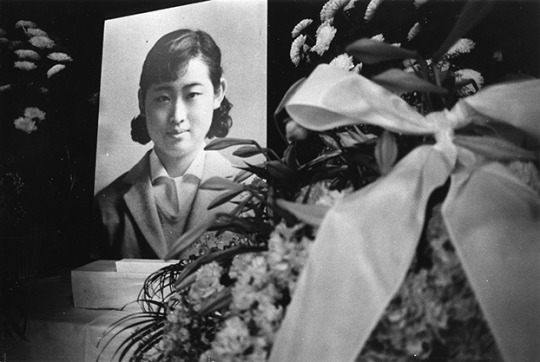

#Jun.15.1960#date of death#Michiko Kanba#樺美智子#University of Tokyo#Zengakuren#60年安保#Anpo protests#history today
2 notes
·
View notes
Text
Who was Nobusuke Kishi?

Nobusuke Kishi (岸 信介, Kishi Nobusuke, 13 November 1896 – 7 August 1987) was a Japanese bureaucrat and politician who was Prime Minister of Japan from 1957 to 1960.
Known for his exploitative rule of the Japanese puppet state of Manchukuo in Northeast China in the 1930s, Kishi was nicknamed the "Monster of the Shōwa era" (昭和の妖怪; Shōwa no yōkai). Kishi later served in the wartime cabinet of Prime Minister Hideki Tōjō as Minister of Commerce and Vice Minister of Munitions, and co-signed the declaration of war against the United States on December 7, 1941.
After World War II, Kishi was imprisoned for three years as a suspected Class A war criminal. However, the U.S. government did not charge, try, or convict him, and eventually released him as they considered Kishi to be the best man to lead a post-war Japan in a pro-American direction. With U.S. support, he went on to consolidate the Japanese conservative camp against perceived threats from the Japan Socialist Party in the 1950s. Kishi was instrumental in the formation of the powerful Liberal Democratic Party (LDP) through a merger of smaller conservative parties in 1955, and thus is credited with being a key player in the initiation of the "1955 System", the extended period during which the LDP was the overwhelmingly dominant political party in Japan. Kishi backed up numerous organizations of far-right-wing causes including Korea's Unification Church (Toitsu Kyokai), the Asian People's Anti Communist League, the Moral Re-Armament Movement, and served as an adviser for the association of war veterans (Nihon Goyu Renmei) and of the national fascists (Sokoku-boei Doshi-kai) advocating the destruction of democracy.
As prime minister, Kishi's mishandling of the 1960 revision of the U.S.-Japan Security Treaty led to the massive 1960 Anpo protests, which were the largest protests in Japan's modern history and which forced him to resign in disgrace.
His younger brother, Eisaku Satō, also was a prime minister. Kishi was the maternal grandfather of Shinzo Abe, twice prime minister and defense minister Nobuo Kishi.
Source: https://www.foranewworld.info/pt-br/node/27746
#nobusuke kishi#kishi#far-right politics#ldp#liberal democratic party#japanese politics#politics#right-wing politics#fascism#fascist#Asian People's Anti Communist League#apacl#anpo protests
0 notes
Text
I've deleted tiktok off my phone and now mainly use Instagram reels. I get a bunch of content related to Japan (makes sense I'm moving there) but omfg the comments are like the trenches. Some are purely racist to Japanese citizens and others are such Japan dick riders that it's insane.
Anyway recently got a post about a white guy complaining that TOKYO has gotten too "foreign" and that he doesn't want Japan to "lose" their culture. I've got a lot of thoughts on this but nowhere to put them so here they are:
I'm literally losing my mind at how many people think Japan is this orientalist non-westernized country when Japan has westernized itself since the 1890s. Losing my mind at foreigners in Japan complaining that there are more foreigners in Japan and acting like they've been in Japan since before it when they moved there in like 2010.
Saw someone comparing Japan to Hawai'i in how it's losing its culture (truly mindboggling considering what Japan has done to Okinawa) and another guy who's name was literally Noah saying "Americans should keep their bs out of japan no one wants your stupid westernization" like dude ur name is Noah.
Also, no part of America has "westernized" Japan since the early 20th century, and Japan's "westernization" is entirely Japan's own doing for wanting to be in proximity to whiteness. No other culture country or people gets to decide where Japan's culture gets to go, that is solely up to the Japanese people (mind you not the government but the PEOPLE)
Most people obsessed with Japanese culture have never read an actual book on Japan that goes beyond "Japan has shrines that worship the kami or spirits of the world" and "being polite is important as a tourist in Japan". If they did, then they'd know that during the pre-war era and throughout the wartime era, the Japanese government purposefully put out cultural propaganda in order to boost nationalism. They wanted Japan to seem entirely unique and therefore more special than all other Asian countries. This is not to say Japan does not have beautiful cultural traditions that extend centuries, but largely those have been transformed and marketed to Japanese and foreign tourists alike.
Shrines and shrine groups donate and mass support alt-right-wing groups in Japan. The over-politeness culture is part of the awful workplace conditions and suicide rates. Actual Japanese people have spoken to these facts but that does not mean they do not like their home culture. Globalization/modernization will not westernize Japan. Women's rights, LGBT rights, labor rights, and immigrants' rights, will not westernize Japan. They will save Japan.
These Japan-obsessed right-wingers will ignore the hundreds of years of protests and civil rights groups to create an orientalist idea of Japan. None and I mean NONE of those people care about Japan, Japanese culture, or Japanese people, they only care about living out their orientalist fantasies while actual Japanese people living their daily lives are simply background props.
We need to stop pretending Japanese people are not their own people with history, culture, and movements.
Here are just SOME links on Japanese politics not known by most people (please message me if you're interested in these topics or would like more resources):
Nippon Kaigi- Alt Right Religious Group
Japanese Work Culture
Ainu - Indigenous Group of the Lands in the Okhotsk Sea
Ryukuans (Okinawans) - Indigenous Group of the Ryukyu Islands
Scream from the Shadows- A Book on the 60s Feminist Movement in Japan
Chizuko Ueno "Forty Years of Japanese Feminism" - Prominent Japanese Feminist
Burakumin - Lowest "Caste" Group in Japan
Zainichi Koreans - Resident Koreans Who's Families Entered Japan During and After the War
LGBT Rights - LBGT+ Rights Group in Japan
Organizing the Spontaneous - 60s ANPO Movement
Sadly I cannot find the twitter page that often posts modern-day Japanese news that normally is not posted by other news organizations. But if any of you remember it please send me the page so I can add it as I believe it is an important resource. Or just reblog with it!
Look, whether you like or dislike Japan, remember it's a country with people just like anywhere else. Do not dismiss the work activists have done in Japan. Do not say Japan "needs this political movement", instead talk about how Japanese progressive groups need international support and recognition (mind you don't say this about any country, especially largely nonwhite countries!!! you are completely ignoring and rejecting the work millions have put into social change!!! instead talk about those people!!! talk about those movements!!! don't let their efforts be forgotten!!! don't let any government tell you these movements are new!!! THEY AREN'T!!!!). One of the biggest ways we can create change and push away alt-right groups and people from any place is by ruining their image of those places.
Do NOT let the alt-right in Japan convince you Japan is purely homogenous and that Japan is the best country in the world. Do not let the Japanese government erase the Ainu, the Ryukyuan, Immigrants, Zainichi Koreans, LGBTQ+ citizens, women's rights, the Burakumin, the poor, and the communists/progressives of Japan. Do not let ANY country erase that history!
DO NOT LET JAPAN PLAY THE VICTIM TO "WESTERIZATION"
#Japan#Japanese politics#weeb culture#white supremacy#progressive politics#this post got way out of hand and there's still so much to add that i feel bad for leaving things out#anti blackness is something id also like to talk about but i also know there's countless black people sharing their own stories#please feel free to message me if you're interested in further research and information#especially on things like anpo the ainu ryukyuans and burakumin#if anyone is interested i have a massive paper on burakumin political action and history post war i wrote#please dm for more resources!!
20 notes
·
View notes
Note
Could you do 72 for r/anpo and p/oe with p/oe as the sick one
Thank you for the ask~~ I can indeed!! First time attempting them, so hopefully it's enjoyable~! (also gotta give credit to onetrickponi for her incredible idea of Karl's tail inducing sneezes from a wav she did that I've absolutely used here, hope that's alright~)
1.9k words, prompt 72, story under cut!
72. Person A hasn’t been sleeping due to work, and they of course get sick. Despite Person B’s wishes, Person A continues to sneak out of bed and stay up late to get more work done, and Person B is not happy.
(Slight warning for anxiety and high fevers, just in case anyone doesn't like those!)
~~~~~~~
The faint light coming in through the window is more than enough for Poe to work with. Pen scratching against paper. Bathing in the moonlight. This has always been his favourite way to compose a novel. Something about the way the light feels soft, and the motions of your hand as you form words, it just feels right.
A drop of sweat makes its journey across his forehead, lunging for the paper until he catches it in his sleeve. ‘The fever is probably getting worse…’ His thoughts are cloudy, but somehow it’s making the words even easier to grasp. As if they’re practically begging to flow onto the page, climbing from his mind down into his pen.
“Poe.”
The noise drags Poe out of the daze, tearing the paper as he manages to drag his eyes up to greet the source. The source in question is wearing a scowl and leaning against the doorframe, eyes shadowed by the hat drooping over his face.
“R- Ranpo… I was- eh’kschh’ieew-! Sorry- I was just, uh- hh’ekzzziew-tezzshh’iew-! Sorry- just w- working on… something…”
“What you should be doing is coming back to bed. I don’t even need to use deduction to see that you’re sick.”
“No, no, I’m quite alright. I’m simpl- simply… heH’keDZZshh’iew-! Sorr-”
“On top of that, I’m pretty sure I remember you promising to sleep tonight. Something about how you haven’t slept in three days, if I’m not mistaken. Which I never am.”
“I’m absolutely fine, I just need to- uhh’dEZZhhh’ieew-! finish a few more chapters and my latest masterpiece will be completed! It will astound you, you won- won’t… notagain- uh’gzzsshh’iew-! eh’kNGzsshhieew-! Sorry…”
Ranpo tilts his head, emerald green eyes revealing themselves. It’s all Poe can do to keep himself from blushing. ‘It seems no matter how many times I see them, I’m never prepared… I wonder if he… feels the same about mi- no. Focus, gotta convince him I can still wri-’ The thought is cut off by Ranpo’s boot tapping against the hardwood floor.
“What I will or won’t do is irrelevant. You aren’t able to complete a full sentence without sneezing.”
“That’s nohuHh-! not true. See? I executed that sentence to perfection without int- interuHH-! huH’KnGT’shiew-!”
“Without interruption?”
“eNGt-! ih’dknzzt-! Sorry… Correct, Ranpo. As usual.”
The words are laced with jealousy, but they can both hear the admiration simmering just before the surface, waiting for a chance to be expressed. Ranpo seems content to accept the praise without acknowledgment, focusing on the task at hand. ‘Just like a true detective. Not sidetracked by mere personal matters. I was never able to match that determination…’
“You’ve been falling into the same pattern for weeks, staying up until you pass out, sleeping for a full day, then repeating. We’re both smart enough to know schedules like that lead to illness.”
“I’m.. smart enough..?”
Ranpo lets the hat dip back over his eyes, his face returning to neutral. His hand extends, Karl chittering from atop his shoulders.
“Back to bed now and I’ll let you off with a warning.”
“But-”
“Besides, I’m tired, and Karl won’t let me sleep unless you come too.”
Said raccoon chitters again, crawling from Ranpo’s arm to Poe’s shoulders. ‘Two against one, this is hardly fair…’ Poe protests, oblivious to the lack of noise from his mouth as the thought stalls itself in his head. Despite this, as Ranpo’s hand brushes his own, he can feel every ounce of resolve draining from his body.
“Bed.”
“Okay, Ranpo, you win. Again.”
Confirmation of success seems to be all Ranpo was looking for, as he turns and walks down the hall. As if there was a string tying them together, Poe finds himself unable to resist the urge to follow. It’s not until he’s laying in bed next to Ranpo does the fever finally bring out the sleep hiding behind his eyes. Muffling a sneeze with his pillow, Poe starts to pull himself from the sheets.
“heh’mmMDZShh’oo-! Sorry… I’ll sleep on the couch-”
“No way. It’s your house after all, I’m just staying over. Besides, Karl will leave too, and I want my cuddle time with him.”
Poe lets a whimper break free as Ranpo’s arms seem to crush the life out of his dear friend, ‘Though strangely, Karl seems to have no problems with this arrangement.’ Instead of fighting, Karl’s snuggling deeper into Ranpo’s chest, breathy snores starting to pour out of both of them. Feeling sleep start dragging his eyelids shut, Poe’s own breath soon evens out, joining the ensemble with a congested tone of his own.
~~~
The air seems to burn as it infiltrates his lungs with each inhale. Poe leans against the wall, legs growing heavier with each step, but determination pulls him through. ‘That dream… it was perfect… I know what the novel needs… I know what will- will finally impress Ranpo…’ It hadn’t been more than a handful of hours later that sleep had relinquished its grasp of him, being replaced by a feverish mania as plotlines and characters seem to beat against his skull from the inside. This is why he sits at his desk again, even the moonlight dulled as the clouds gather outside his window.
Pen glides across the paper once more, each word leaving a deeper taste in Poe’s mouth. Ink mixes with sweat as his hands begin to shake. Only half aware of the world, Poe finds himself unable to process the sweat lining his brow being anything other than a hindrance to the plotlines swimming through his mind. Each word on the page seems to dip further into illegibility, moving away from writing and closer to drawings, mindless scribbles as his vision fades along with them.
“What do you think you’re doing?”
“I have… I have to write this… it’s- hh’deZZshhh’iuh-! my best work… my best work ever… it’ll be unsolvable!”
Ranpo’s breath is warm against his neck as the detective leans over to catch a glance of the paper. Poe finds his hands stalling at the sensation, even one extra stimuli sending his brain careening into overdrive, deeper into the fevered abyss, unable to stop thinking, but equally unable to start writing again.
“More like unreadable. Poe, even I can barely decipher what words you’ve written here.”
“It’s messy, but it’s some of the best writing I’ve ever done. I s- see… hH’gndjsshh’aa-! Sorry- I see the world so clearly, it’s almost as if I’m the one transported into it. eh’dnTZShh’oo-! Sorry. No one will be able to crack the mystery, not even you!”
A cool wave washes across Poe’s face, a moan pulling free from his lips as Ranpo’s hand finds what it was looking for on his forehead.
“That’s the fever talking. You need to sleep.”
“hH’INkgt-! djZnnGt-! ehhA’knDt’uhh-! huH’AnGXt-!”
“Bless you, don’t do that. You’re only gonna-”
“hehHh-! dnjSZHh’oo-! S- Sorry… haiHH-! eHSHh’aa-! hH’InkGtzz’iuh-!”
“Bless you again, Poe.”
“Th- hh’knzshhh’oo-! kezzshh-tezsshhh’oo-! Thank you. S- sorry…”
The apology melts into a cough, whistling notes sounding out between each breath, only broken up by the sound of pen against paper as he attempts to continue this chapter. Each word is violent, looking as if the person forming them had never written before, lines uneven and frantic as the cough brings tremors through his fingers.
“You don’t sound good.”
“I’m f- fine… I need to finish… need to finish this chapter…”
“I apologize for the methods I must resort to.”
The words fall on deaf ears, Poe’s brain being submerged into feverish concentration once more. He doesn’t notice Ranpo turning away and whispering something to the raccoon perching atop his shoulders. Nor does he notice Karl climbing up his back until a soft paw steps against his hand, pen cracking on the paper.
“Karl? What are yo- GuuHhH-!”
A single swish of fluff against his face is enough to break Poe out of his trance, buzzing starting to spread up to his ears as the tickle surges. Ranpo’s arm intertwines with his, Karl climbing back onto his shoulder as he pulls the writer up. Poe attempts to aim away from either of them with the fit he cannot seem to subdue.
“hh’DjZshh’oo-! aiYZShh’aa-! hH’KEZzshh’oo-!”
“Bless you.”
“C- can’t- dnGt’Zzshh’oo-! hehHh-! hH’INZSHhoo-!”
“I know. Bless you.”
Poe feels something soft being pressed against his face, his body sinking into the bed as he’s sat down. ‘What’s pr- pressing on my fa- face… I need to… I’m- I can’t..’
“Blow.”
“Wh- hAH-! What? hH’iNgT-! kndZnt-!”
“Blow your nose, Poe. It won’t end until you do. I’ve got you, just blow.”
Doing as he’s told, Poe feels the fever swell against his cheeks, moving up into his ears. ‘Or maybe that’s not the fever… am I blushing..? I can’t… I can’t tell…’ His voice is drowned out, even in his own head, a deep fog overtaking his conscious thought.
“I’m s- sorry Ranpo…”
A soft hand brushes against his face, Poe practically melting into the touch as his hair is swept away. His vision clears, for more reason than one, as Ranpo’s eyes stare back into his. This exchange only lasts for a minute, but it starts to play on repeat in Poe’s mind as Ranpo rests his forehead against Poe’s, voice barely above a whisper.
“I’ll read the book the instant you finish it. I promise. But only if you’re not sick while writing it.”
“B- but…”
“You want to be able to give me your best, right? Don’t I deserve that?”
“Of course y- hH’dzzshh’oo-! you do-”
“Being sick is not your best. Let me take care of you, once you’re better, you can write it.”
Waves of emotion seem inclined to suck Poe into their current, he’s barely able to keep his head above their waters. Guilt and anxiety claw at his legs, pulling him into the ground. And yet, something softer frees him, a wave of pride and love bringing air back to his battered lungs. ‘He thinks I have a best… something he wants to see… and… he wants to take care of me.’
“Besides, no one will be able to read it if you keep writing like that. It looks like you were driving consistently through potholes while attempting to transcribe a conversation from a language you don’t speak.”
“W- well that’s not very kind… but it was quite visual.”
Ranpo laughs, giving Karl’s head some scratches as he drapes himself across the bed next to Poe, raising an eyebrow as he tosses out-
“Maybe I should write the book instead.”
Poe freezes, eyes peeking out from the curtain of hair as they widen. Terror infiltrates his dazed mind, fighting against the urge to give Ranpo whatever he desires, a war neither side can win. The battle, however, is quickly cut short as Ranpo places his hand on Poe’s arm, a gentle touch that quiets all voices but his.
“It was a joke, Poe. Now, let’s get you back to sleep. I need my rest, and you’re keeping me up.”
“Alright, Ranpo. Th- thank you.”
“No need for thanks! But~ there is need for rewards. You owe me at least some chocolates. And some lollies. Oh- and more of those gummy sushi things you ordered internationally, those were good… Oh! And-”
A smile spreads across Poe’s face as Ranpo goes on, the haze in his mind starting to gently overtake the last piece of his consciousness as the sheets beneath him start to encase him in their soft embrace, matched only by Ranpo’s softer touch against his arm. Poe manages to get out one last sentence before sleep wins out.
“Whatever you want…”
“I’m holding you to that!”
#waterfallasks#waterfallwrites#thank you so much for the request!! i really enjoyed trying these two#theyre just SO adorable i have so much love for them and their dynamics#to anyone who reads this- thank you!! and i hope you enjoy <3#b/sd#r/anpo#p/oe#r/anpoe#snz#snzkink
30 notes
·
View notes
Note
Re that post about Kenzaburo Oe, you mentioned the term 1968 kids, talking about him and Hayao Miyazaki, how would describe that group? I get the gist of a certain kind of utopian artist from that generation, but I haven't heard it before, wondered if there was any other traits/anyone else you'd put in that group?
Definitely worthy of a fuller write-up, and I wish I had a concrete "unifying" source for all this, but Japan had a rapidly growing leftwing radical movement in the 1960's. The Anpo protests, a huge series of demonstrations against the US-Japan Security Treaty (which gave the US military bases in Japan) from 1959-1960 were the launching point, and they built on growing movements of unionization, environmental activism, and anti-militarism. It culminated in the 1968 seizure of much of the campus of the University of Tokyo by the 'Zenkyōtō' student activist faction, which was part of a global wave of student activism in 1968.
And like in so many places, 1968 was this movement's high water mark - they were awash in factionalism, police broke up their occupation, and support for them plummeted in the face of the violence they both initiated and recieved. In the 1960's members of these factions thought that they could seize political power, change the state, all that jazz. By the 1970's that dream was dead.
Most political-style artists were part of this movement, and shaped by that break - as political opportunity faded, they saw in their art a way to express their concerns, visions, etc that the political system would not. Since I am an anime person, this is where a lot of leaders of 70's and 80's anime would emerge from. Hayao Miyazaki and Isao Takahata were both animators at Toei Animation during this time, got heavily involved in the union efforts there - Miyazaki was the union's general secretary in 1964 - and were avowed Marxists. Mamoru Oshii was similarly active, participating in the Shinjuku Riot over the Vietnam War and identifying as Trotskyist-Left. There is an entire genre of Japanese cinema called New Wave which was part of and shaped by this movement - director Shūji Terayama would be a notable for films like 1971's Throw Away Your Books, Rally in the Streets, which I will mention because its creators included theatre director and music composer J. A. Caesar (real name Takaaki Terahara) who composed the soundtrack for Revolutionary Girl Utena, for the anime connection. There are of course hundreds more I could name.
I think their themes are well known - what united them as a 'movement' was A: they all mutually saw themselves that way, and B: they are the last generation to believe that their art could truly change minds. Miyazaki is making Nausicaa because he actually thinks it will turn people away from techno-fetishization, stuff like that. Creators after that make works about society, but they don't view them the same, their ambitions are different - insight vs activism, or reform vs revolution. Of course these creators will age and change - Oshii for example did so, he would famously criticize Miyazaki of being a typical "Anpo man" in feeling like his films were responsible for society and the world, saying such responsibility was itself a form of fascism (its Oshii, he says shit like this all the time). In his criticism you can see the identity of the 1968 generation reflected back.
They were more-or-less wrong, of course - art can change things, but not that much, and it turns out politics is way more complicated then their visions could contain. But I respect their conviction dearly and find the art they made to have something irreplacable due to that conviction, so its worth remembering.
43 notes
·
View notes
Text

Let's take a look at Cutie Honey episode 15: “Looking Back with Tears of Rage.”
Screenwriter: Susumu Takaku
Art Director: Eiji Ito
Animation Director: Joji Kikuchi
Director: Osamu Kasai

There is a fair amount of political satire in this episode, specifically when Miharu makes a speech to the masses regarding inflation and when Danbei and the others come to help Honey. The latter of which appears to make light of the Anpo Protests, which were against the renewal of the revised U.S.- Japan Security Treaty.
Thanks to Skaro Hunting Society for this tidbit!

Despite being a relatively important episode, there are a few mistakes present in the script.
Alphonne is shown to have PTSD over the burning of St. Chapel Academy. This doesn’t make sense because she wasn’t present for the school's fall. At the end of the previous episode we see Alphonne returning to the school grounds, completely oblivious to the destruction that occurred the night before.
Miharu also has a traumatic flashback over the school’s burning and starts yelling “the students are in danger!” However, the only students at the school during the fire were Honey and Natsuko. Miharu of all people should know this, considering she was the reason they were the only two students on campus at the time.
While not as glaring as the aforementioned mistakes, Honey somehow knows Snake Panther’s name. Jill also refers to Zora as "Sister Zora" in this episode only.
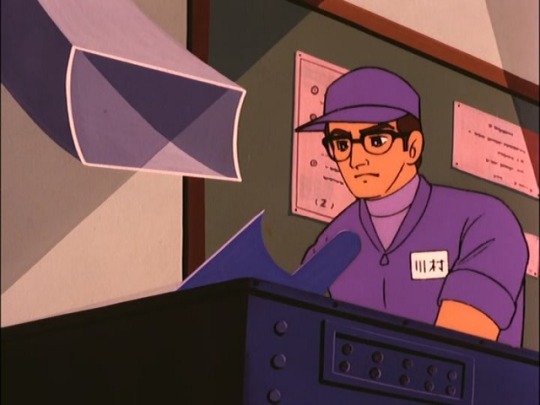
The poor newspaper employee who falls victim to Snake Panther is named Kawamura, a reference to one of the animators who worked on this episode: Nobumichi Kawamura.
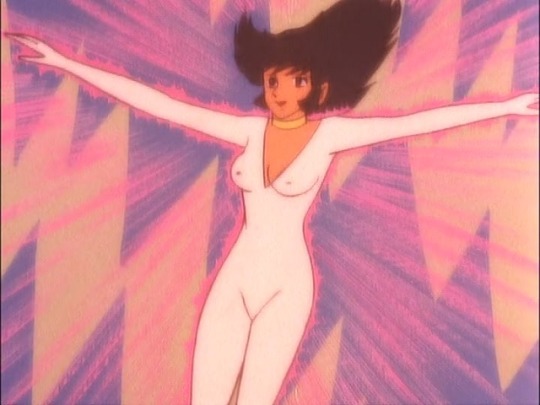
While Toshio Katsuta agreed to Go Nagai’s idea of featuring Honey nude during her transformation, he did urge the staff not to draw her with nipples and to avoid showing her “important parts” or any excessive up skirt shots. While the staff usually compiled, there are a few instances of rebellion. This episode is the first of three to depict Honey with nipples.

Despite his real name appearing in the credits for key animation, Joji Kikuchi (菊池城二) is given the alias Jonichi Kikui (菊井城一) for his role as animation director.
Tune in next week for "From the Casino with Love."
6 notes
·
View notes
Text
Animation Night 130: Hayao Miyazaki’s Aeroplane Movies
Oh that Hayao Miyazaki! We sure have a slightly complicated relationship to him here on Animation Night!
See for example...
Animation Night 70, where I talk about his early career and years as a Toei union man, up to the founding of Ghibli;
Animation Night 100 where I tell you about one of my favourite ever films Mononoke-Hime;
Animation Night 111 where we look at the fascinating My Neighbour Totoro-Grave of the Fireflies double bill of 1988.
Tonight, we’re going to look at two films, Porco Rosso and the controversial The Wind Rises, which indicate his particular arc through life in, honestly, a rather sad way. Putting them alongside each other to see what we learn...
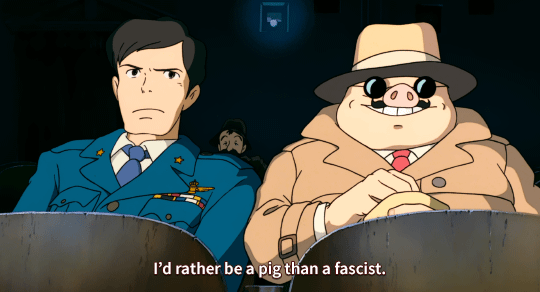
If there’s one thing old Hayao loves, it is aeroplanes - particularly planes from the early-mid 20th century. No surprise, really: his dad Katsuji Miyazaki ran a company Miyazaki Airplane, which manufactured parts for world war II aeroplanes such as the infamous Zero fighter plane. (Put a pin in that one!) Despite working to arm the Imperial Japanese military, Katsuji was able to get out of actually serving in the war by telling his commanding officer that he didn’t want to fight when he had a wife and kid, which somehow got him discharged with just a lecture.
The young Hayao, born 1941, was therefore surrounded by planes, which were the source of his family’s comfort. He spent his earliest years fleeing from American air raids, suffering from digestive problems, and watching his stern, intellectual mother Yoshiko suffering from spinal tuberculosis (though she ultimately made it to 1983, at age 72). At school in the 50s, he took an interest in manga - which in those days naturally meant Osamu Tezuka; he also went to see drama films with Katsuji such as Meshi (1951).

In ‘58, he saw Toei’s Legend of the White Snake (白蛇伝 Hakujaden), notable as the first colour anime film, sneaking out from studying for his exams. The film had a profound effect on him. In Starting Point, he writes that he fell in love with the film’s heroine Bai-Niang, and yet gradually started to imagine how he might have done the film differently to better show the secondary characters.
Hayao went to university to study political economy with a focus on ‘Japanese Industrial Theory’, and at the same time, started drawing in earnest, cranking out thousands of pages of manga and spending a lot of time sketching and chatting politics with his middle school art teacher. The 60s and 70s were a high point of left-wing activity in Japan, the time of the Japanese New Left and the Anpo protests against the US-Japan security treaty (c.f. Toku Tuesday 33 on Nagisa Ōshima for a truly fascinating filmmaker who rose to prominence at this time!) So Miyazaki fairly naturally became a Marxist, and stayed such as he got his start working in animation, which I’ve covered in other posts.

So at this point perhaps we can see the curious contradiction that sits in so much of Miyazaki’s work: he genuinely loves aeroplanes and other kinds of military hardware on a kind of aesthetic level, and yet this sits pretty curiously against a worldview that went from Marxist to environmentalist and has no love of war or nationalism.
With all this in mind, let’s take a look at a few of Miyazaki’s early depictions of planes. First would be his work on episode 21 of Moomin (1969), by TMS entertainment. On this infamous episode, Miyazaki’s senpai Yasuo Otsuka called in his protégé to handle of all things a battle scene with planes and tanks - one which infuriated Tove Jansson, already dissatisfied with the tone of the adaptation, to the point that she pulled the show out of TMS Entertainment and A-Pro’s hands and gave it to Tezuka’s rival studio Mushi Pro instead.
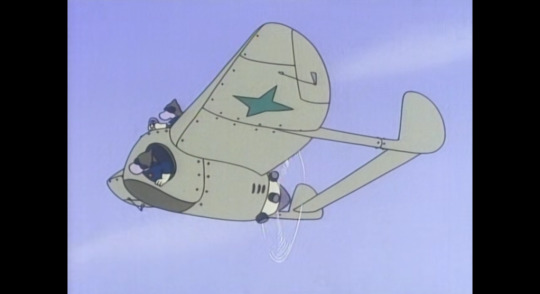
(I can’t find any embeddable version, but I did get my hands on this episode eventually! Lain bless soulseek.)
This did not deter Miyazaki at all. In his work on ‘Green Jacket’ Lupin III Part I, which he co-directed with Takahata and Masaaki Ōsumi as well as animating several scenes, we start to see his love of mechanical detail shine through once more. Miyazaki’s plane obsession would shine through even more strongly with his direction of two episodes of ‘red jacket’ Lupin III Part II (1980), under the pen name “Tsutomu Teruki”, directing animators like the spectacular Kazuhide Tomonaga as @kbnet documents here. By that point his style had matured - the character designs and motion feel like something drawn in Ghibli’s early years, and the plane backgrounds are astonishingly dense with detail. The Castle of Cagliostro is by comparison relatively light on aeroplanes, but truly elevates Lupin’s car to a character - not to mention the film’s ridiculously elaborate finale where the characters battle through an enormous system of gears.
In between these two Lupin jackets came Future Boy Conan, where we start to see Miyazaki find more things to say about planes than “damn cool!”; a full of wonderful plane adventures, yet they also represent the sinister forces of industrialism which destroyed the world once and threaten to do it again.
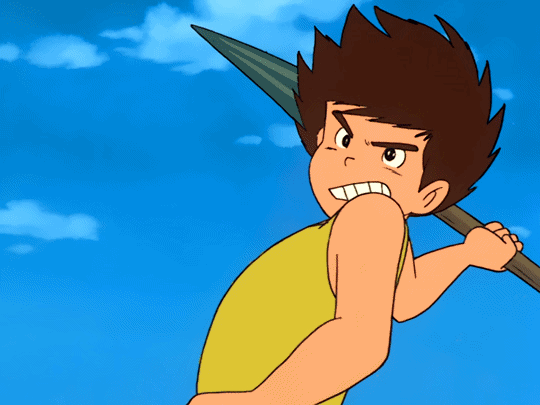
In an essay from 1979 that opens the collection Starting Point, Miyazaki remarks on the qualities needed to animate a plane on Conan, giving a sense of his philosophy around animated machines - and his perfectionism:
Quite a few of toda’s younger animators plunged directly into this line of work because they were fans. But if I were to ask them to draw a picture of what they think a chaika (a flying boat in Future Boy Conan) would look like in flight, they would only be able to imagine what they had previously seen on past TV anime shows. And I wouldn’t be able to use their work as a result.
To draw a chaika flying in a truly original fashion, you would need to have read at least one book on the history of flying, and then be able to use your imagination to augment what you have read.
This is followed by an anecdote about Russian pilot, and builder of the first four-engine biplane, Igor Sikorsky - the man who for Miyazaki “symbolises the way men really fly”.
Miyazaki of 1979 seemed to have a lot on his mind about the relationship of humans to machines. He criticises the mecha shows of the time for a lack of focus on how the character creates and maintains the machine: “the protagonist should struggle to build his own machine, he should fix it when it breaks down, and he should have to operate it himself”. And true to form, when Miyazaki’s films portray machines, there is as much loving depiction of the maintenance as the actual machines in flight.
We’ll fast forward now, since I talked quite a bit about The Castle of Cagliostro, Nausicaa and Castle in the Sky back on AN 70, and Totoro back on AN 111. I haven’t covered Kiki’s Delivery Service yet, although you can trust we will before too long! No, the first film of interest to us tonight is a bit of an oddball in the Ghibli oeuvre; well known to fans of the studio but not quite as much of a household name. That’s Miyazaki’s flying pig movie, Porco Rosso (紅の豚 Kurei no Buta).

^ here’s your obligatory Yoshinori Kanada-animated background animation scene!
Porco Rosso is Miyazaki’s first movie to not just feature planes, but be truly overwhelmingly about planes. Set in a vaguely Mediterranean world, it expresses Miyazaki’s nostalgia for a lost era of flying before he was born, and yet it’s also tinged with the impending horror of the second world war and the recognition that the planes that Miyazaki loves so much are above all weapons.
Unlike many of Miyazaki’s movies, it centres on mostly adult characters and its narrative arc doesn’t really move to any sort of definite resolution; it’s more a portrait of the era, or rather, Miyazaki’s fantastical imagination of the era, in which there can be sky pirate families flying with dozens of children and, of course, a man can get transformed into a pig. The central character of the film, the eponymous Porco Rosso (so called because he’s a pig (porco) that flies a red (rosso) aeroplane), is an outcast due to his pig curse, but also perhaps because he insists on flying for himself rather than for the Italian military, a stance that is already becoming obsolete.
So Porco ends up adopting a young aircraft engineer - a bishōjo character in the spirit of The Castle of Cagliostro - who is eager to see the world. The largest conflict in the film is Porco butting heads with an arrogant American pilot over the affections of Gina, a woman who runs a bar for pilots - yet the two are clearly more similar than different.
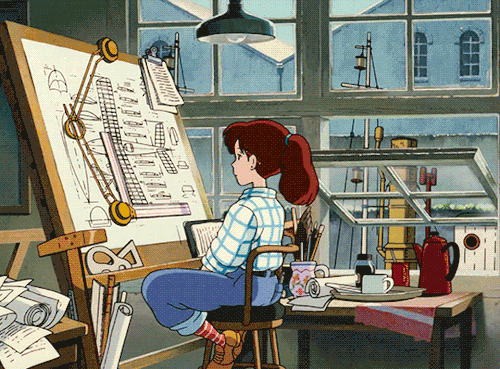
By this point Studio Ghibli is well-established, and Miyazaki can take his pick from some of the best animators in the entire industry. So we see not just Yoshinori Kanada, but also sakuga aces Mitsuo Iso(!!!) and Shinya Ohira(!!!), and with Ghibli money they can truly go all-out. All that attention to mechanical detail, the buliding of machines, is there. Events like the testing of an aeroplane engine are accompanied by incredibly complex multi-layered shots that only a drawing demon like Ohira could accomplish. Only someone whose grasp of 3D form is as precise as Mitsuo Iso could animate some of these shots of subtle wobbles in the pre-CGI era. And on top of that, the colour design of Michyo Yasuda is there in all its beauty, Joe Hisaishi truly came into his own with a score as wistful and nostalgic as such a film demands; it’s an incredibly accomplished work of animation.
But, planes though.
One of the film’s most memorable scenes - one which unites the two films we’re going to see tonight - sees Porco fly up high into the sky to a kind of flying graveyard of aeroplane pilots. It’s here we especially see the ambivalence that obsesses Miyazaki: he finds aeroplanes one of the most beautiful things in the world, idolises their pilots, and yet of course this period of aviation was an incredibly dangerous one, and moreover the aeroplane development was catalysed by war and soon would lead to a level of destruction never seen before in human history with the bombing campaigns of the second world war.
It would be natural to imagine that the workshop where Porco recruits Fio may in some way resemble the workshop run by Miyazaki’s parents - in spirit, as he imagines it, if not in detail. Like Miyazaki Airplane, this workshop in Italy cannot be doing anything but supplying aeroplanes to Mussolini, and indeed we see Porco utter one of the most quoted lines in the film when he tells his old air force buddy “I’d rather be a pig than a fascist.” even though this leaves him essentially a fugitive, on his own with a plane and a girl (like half his age I guess?).
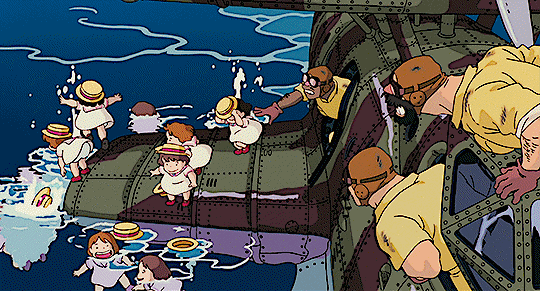
^ This swarm of tadpole-like children was animated by Masashi Ando.
If you actually read Miyazaki’s comments about his dad, it seems a little different. Far from being lovingly crafted, Miyazaki writes, Katsuji would make defective parts and bribe officials to look the other way. He would go to nightclubs right into his 70s and ask Hayao if he’d started smoking yet.
At the time this film came out, Hayao Miyazaki’s father Katsuji would die only a couple of years later, in 1993. We can find a short piece that Hayao wrote about it in Starting Point (page 208-209, My Old Man’s Back):
...And after the war, he had no sense of guilt about having been involved in the military arms industry or having produced defective parts. In effect, for him war was something that only idiots engaged in. If we were going to war anyway, he was going to make money off of it. He had absolutely no interest in just causes or the fate of the state. For him the only concern was how his family would survive.
(...)
When he died two years ago, those of us who gathered together agreed that he had never once said anything particularly lofty or inspiring. If I have one regret, it is that I never discussed things seriously with my old man. From the time I was young, I always looked at him as a negative example. But it seems, after all, that I am like him. I have inherited my old man’s anarchistic feelings and his lack of concern about embracing contradictions.
So the actual reality of aeroplanes around Miyazaki had little to do with the romantic images we see in his films. But that ‘lack of concern about embracing contradictions’ seems important...

In 2013, 20 years after Katsuji’s death, Miyazaki would direct a new film, The Wind Rises (風立ちぬ Kaze Tachinu, lit. The Wind Has Written) - to date, his last film, although of course like clockwork he’s since come out of retirement to work on another one. Ostensibly, this film is a biopic of Jiro Horikoshi, the inventor of the Mitsubishi A6M Zero fighter plane so vital to the Imperial Japanese war machine.
However, if you look into the details, you soon realise that the story present in the film - particularly its central element of Jiro love interest and eventual wife Naoko Satomi - is a complete fiction. Jiro Horikoshi did marry and eventually had five children, but there is very little information about them, even in Horikoshi’s own autobiography. An article comparing the film against it remarks...
The Story of the Zero Fighter is 80% plane design ideas, measurements and stories surrounding Jiro’s career. There’s so much focus on the construction of the planes there’s a measly 20% left for autobiographical material.

According to that article, Horikoshi’s autobiography describes his initial thrill at reports of the Zero’s success in the invasion of China, then later, the psychological impact of a bomb striking nearby and his gradual realisation of what a war actually meant. It’s an arc towards increasing horror at the measures the Japanese Empire was taking to win the war with it, particularly the announcement of the Kamikaze suicide-bomber tactic:
Jiro was approached by the press to write a short essay on the Kamikaze, but he declined. He found it too emotionally difficult to think when he looked at photographs of smiling pilots boarding Zero’s, knowing they were doomed to death. Sobbing, the only sentiment that encouraged him to put pen to paper was dedicating his writings to the families who had lost their loved ones in the war. In the haunted depths of his mind he wondered why Japan had not just given up the war, and why they had gone to such measures with the Zero’s.
Very little of this arc makes it into The Wind Rises. Nationalism is glimpsed only at the margins. In one trip to Weimar Germany, Horikoshi witnesses a Jewish man being pursued; later, he meats a privately anti-Nazi German man at the hospital who talks briefly about how foolish nationalism will make a country ‘blow up’, and his final oblique conversation with the dream-ghost of his idol, Italian aircraft engineer Giovanni Cabroni, about what it means to build planes when they will be tragically be destroyed.
Instead, we find Miyazaki draw in a different source for the primary character arc of this movie: a novel by Tatsuo Hori that also has the title 風立ちぬ Kaze Tachinu. Set in a sanitarium much like the one in which Horikoshi spends the latter half of the film, it tells the story of the relationship between a nameless protagonist and a woman dying of tuberculosis.

It seems an odd connection at a glance: why would you take this seemingly entirely unrelated novel and apply it to an actual historical person? To me, the most plausible answer is that this isn’t really a film about Jiro Horikoshi. Because recall that, of Miyazaki’s parents, his mother also had spinal tuberculosis, and his dad also made planes for the war. Yet, the Horikoshi of this film hardly resembles Katsuji Miyazaki either, who we’ve seen was far from a workaholic like the film’s Jori Horikoshi. Instead, this would better resemble Hayao himself. So instead, it seems to be using this historical setting as a kind of place to explore Miyazaki’s feelings about his parents, his own craft in animation (wedded to the technical industrial world as it is)...
Inevitably that’s a pretty fraught thing to do! More so than any of Miyazaki’s other films, the film sparked a lot of controversy, mostly for how it handles the topic of the war. You could argue that like, OK, do you need a movie to moralistically lecture you on how invading most of Asia was bad? Must it rub our faces in the atrocities committed by the Imperial Japanese Army and Navy to be a worthwhile movie?
One answer is that with the amount of modern nationalism and historical revisionism out there, it might not go amiss for national hero Hayao Miyazaki to take a stand there! But honestly it’s more that, with such subject matter, seems to go out of its way to avoid showing what the Zero was actually used for. The main tragedy, as far as Horikoshi was concerned, seems to be that so many pilots of this beautiful aeroplane die; that his pursuit of engineering beauty was corrupted by worldly matters like a war.
Which isn’t necessarily a completely inaccurate portrait of the real Jori Horikoshi’s attitude to his creation. The quote that inspired the film was “All I wanted to do was to make something beautiful.” But then this film goes out of its way to emphasise Horikoshi as a caring family man, a wholly sympathetic character, when to much of the world, Jiro Hirokoshi is a symbol of....

That. (And that’s the low estimate. It could easily be four times higher.)

But let’s look at how it relates to old Hayao and the contradictions he talks about living. If not to the same degree as old Isao Takahata, Miyazaki is an infamously exacting and demanding boss, heavily correcting nearly every cut that passes his desk. He’s spent his life working at a frankly kind of insane pace and expects his employees to keep up. Studio Ghibli has at least one dead body on its hands. Yet if you look at his films, they’re all about freedom and romanticism and the importance of enjoying nature. In Totoro, the dad is pulled away from his desk to play outside by his children. Probably not a good idea at Ghibli.
Then there are all the family relationships, all the way from the panda in Panda Kopanda to the mother in Ponyo. But Hayao Miyazaki was a distant father (he writes in Starting Point that his children were basically raised by their mother), and infamously callous to his son Gorō when he attempted to direct a film that Hayao didn’t think he was ready to handle.
Can we analogise animation to an aeroplane? It is beautiful in much the same way as an aeroplane is: elegant shapes, the technical coordination of many disparate parts to achieve an effect that would perhaps otherwise sound far-fetched (a flying machine? a picture that moves?). What’s the cost of animation? Well, thankfully nothing comparable to killing millions of people. But it is not a light undertaking. It is something that does eat lives. Is that a comparison that Miyazaki would have had in mind? I doubt it, honestly, but it’s what occurs to me faced with this film.
Thus I read the film’s Jori Horikoshi is a strange emotional blend of Hayao Miyazaki himself, an idealisation of his father or perhaps the sort of man he wishes his father was, and the real man who invented an effective fighter plane which helped enable his country to pillage most of Asia. And the rest of us? Well, the person working through these contradictions is Hayao Miyazaki, at the head of one of the highest concentrations of skilled animators the world has ever seen, so it’s going to be shared with nearly everyone. Would it probably have made more sense to do this in something like a manga, instead of a high profile movie? ...Well, I think so. But that’s not what happened, so we have this movie.

Inevitably for a late Ghibli movie, this film is crazy good looking. No Yoshinori Kanada anymore since he died in 2009, but Shinya Ohira is still alive, and he is absolutely capable of handling a Kanada-like background animation sequence. One of the most breathtaking sequences is the portrayal of the Great Kantō Earthquake by Atsuko Tanaka and Taichi Furumata, which combines both brilliant multiplane shots and unbelievably complex full background animation scenes of waves rippling through houses and streets. Tanaka also handled these mindblowing shots of cloth flowing in the wind as Naoko paints that form the film’s major recurring image.
The film uses slightly more digital compositing effects than the 90s pre-digital Ghibli films. For the most part the colours are just as lush as those older films, and there’s even very effective use of CG with handpainted textures now and then; Ghibli weathered the transition to digital a lot better than many studios.
And yet, despite all of this, it is a movie that leaves me feeling pretty unsatisfied, like a lot of late Ghibli movies. Hayao Miyazaki has said that he’s attempted to move away from familiar kishōtenketsu structures and try something novel, but when I watch films like Howl’s Moving Castle, I’m left wondering like... what did all of that amount to, in the end? For all its spectacle, what is this film even saying that Porco Rosso didn’t say... honestly, say better?
Maybe I’ll find an answer on a rewatch. It’s... far later than I planned to start, but if you’re willing to join me, please hop into twitch.tv/canmom and we’ll watch Hayao Miyazaki’s two big films about planes! And I’ll show you the Moomin thing too.
68 notes
·
View notes
Text
No Regrets for Our Youth
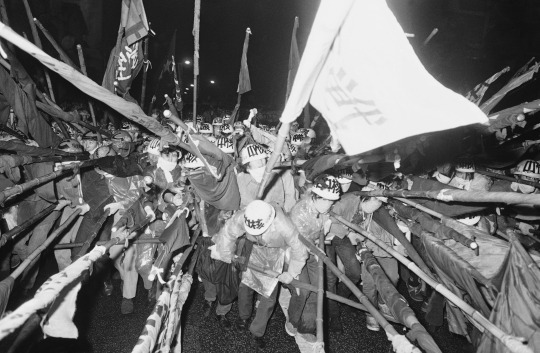
I thought this movie was excellent in some parts, and pretty boring in others.
I was really excited when I realized this was a movie about leftist student protests, because I find that subject pretty fascinating. After reading about the Anpo protests in Haruki Murakami's novels, I read quite a bit about Zengakuren, the coalition of student self-government organizations at the center of university protests both post and pre war. It was interesting to see a film depiction of one of the faculty removal incidents that came to define Zengakuren and their quest for academic freedom.
The opening scene in this movie is beautiful-- an almost comically idealistic portrayal of youth and freedom as Yukie and co. literally frolic in the fields, contrasted by an ominous burst of gunfire in the hills, which symbolizes the threat of militarism and facism for the group we are following.
Noge and Itokawa are fascinating characters. Like many young activists, they come to a point where they must choose to stand by their ideals and put their futures in jeopardy, or give them up and accept the promising careers their prestigious degrees promise. Kitokawa is able to accept the economic consequences of his ideals, but his mother ultimately persuades him to give them up and become a prosecutor. (Family is crucial for Kitokawa. Later he jokes that he only married for his mother's sake). Noge, of course chooses the latter path.
My beef with this movie is that, instead of focusing on these two characters, it focuses on Yukie. I understand that Yukie's romantic choice of Noge is intended to reflect the attraction of idealism and danger, but still. Call me sexist, but she's kind of boring compared to the other characters. I would rather see Noge engage in slick covert operations than watch Yukie give him a big hug when he gets home. Respect to Yukie, she goes hard in the rice fields, and I think she certainly comes into her own by the end of the movie, developing her own political passions. But the section in the country is basically just a farming montage, and it didn't keep me engaged.
Maybe I'm just TikTok action movie brained, but I felt like this movie never game me the scenes I wanted. Like, show me some protests scenes. Why can't I watch the farmers come in and destroy Yukie's rice fields? Why do I have to see the aftermath? It seemed like Yukie's father in law having his stupor broken by the destroyed rice fields and crying out in rage is supposed to be a powerful moment, but I didn't really care about him, so it just sort of fell flat.
Still good tho.
2 notes
·
View notes
Text
Hidden Histories: Kyu Sakamoto, the last Asian soloist to reach No.1 on Billboard Hot 100 in 1963
We only had to wait 60 years for someone else from the region to reach the top spot.

"Ue o Muite Arukō" was written by lyricist Rokusuke Ei and composer Hachidai Nakamura. The song is kind of a bitter sweet metaphor for the emerging post World War II global expansion of Japan onto the world scene. Ei wrote the lyrics while walking home from participating in the 1960 Anpo protests against the U.S.-Japan Security Treaty, expressing his frustration and dejection at the failed efforts to stop the treaty.
youtube
In the West, it is best known as "Sukiyaki", the name of a Japanese hot-pot dish. The word has nothing to do with the song and was used because it was short, catchy and familiar to English speakers. A Newsweek columnist compared this to issuing "Moon River" in Japan under the title "Beef Stew".
Post Date: 04/04/2023
#Ue o Muite Arukou#kyu sakamoto#the last asian soloist to reach no 1 on Billboard Hot 100#jimin#park jimin#like crazy#jimin no 1 on hot 100#level playing field?#I don't think so
10 notes
·
View notes
Note
1. Now we just need to work on the Asian porcelain. 2. My heart belongs to my cats, but thank you for asking. :)
I have an Edo-period bowl already! As well as some postwar stuff, mostly tourist/Anpo protests-era soft-power kitsch, but on the nicer end of that. We'll get there!
Give them a skritch for me and I'll do the same.
0 notes
Text
Cruel Story of Youth
Hm. I don’t know what I just watched. That movie was something and nothing at the same time when I finished watching it. It felt like a fever dream from start to finish with the characters not knowing what they were doing and you were held hostage to watch it all unfold. When the movie first started, I heard people whisper about how sad this movie was and how it had some unpleasant things that would happen to the characters, so I braced myself for what I was about to watch. The first few scenes held true to those words. We saw a young girl being preyed on by a guy, who was then “saved” by a teenager who turns out to be preying on her as well. You could argue that she went along with his requests willingly, but that scene where they were at the shipyard and Kyoshi was doing some funny business really set the scene for the whole movie. I was like, “what is going on with this guy?”. He really was basically just flirting with killing her as he pushed her hand away every time she tried to grab on. (But it was funny when she said that she couldn’t swim, and then she successfully tread the water for a good minute. Speaking from experience as a person who can’t swim, she did much better than me in that situation, so good job to that.)
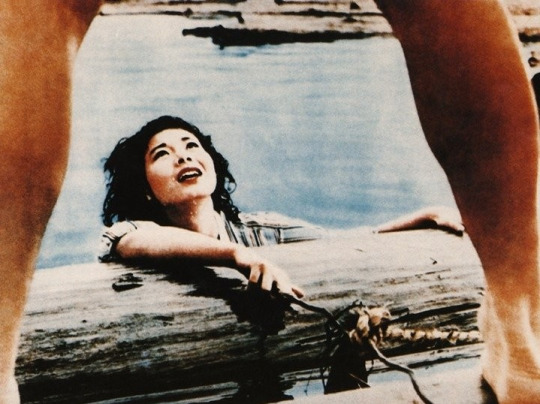
Going back to the story though, Makoto (in my opinion) tries to justify Kyoshi’s wrong actions by telling herself repeatedly that he loves her, so that she doesn’t have to face the truth of her actions. Because while Kyoshi is largely at fault for what is happening to her, you have to remember that she willingly puts herself out there and in the scary nightlife of Tokyo because she wants to act out. She wants to be similar to her sister in running away and experiencing “new” things, when in reality, she is behaving very dangerously and both protagonists don’t reach that conclusion. I wish the story explored more as to how Yuki and the underground doctor were in the past, as I think that could have aided in giving the story more meaning, but it just went on covering the escapades that Makoto and Kyoshi went through. They scammed many people, somehow convinced the human traffickers to give them their scooter (to which they drove into the ocean, as to why? I have no clue) got Makoto pregnant, manipulated her into having an abortion, and then they both died. I can maybe see how it would be attractive to the younger audience back in the day, but the story mainly focused on how sad their life was. I feel like if it focused on the Anpo Protests that they mentioned in the beginning and weaved it better into the story, I would have liked it more. But instead, Oshima chose to put it out as such.
1 note
·
View note
Text
1960-Anpo protests "June 15th Incident"


On June 15, as part of the anti-Treaty coalition's 24th united action, hundreds of thousands of protestors marched on the National Diet in Tokyo. In the late afternoon, the protestors were attacked by right-wing ultranationalist counter-protestors, who rammed them with trucks and attacked them with wooden staves spiked with nails, causing dozens of injuries from moderate to severe, including several hospitalizations.



Just a few minutes later, radical left-wing activists from the nationwide student federation Zengakuren smashed their way into the Diet compound itself, precipitating a long battle with police,[1] who beat the unarmed students bloody with their batons in front of mass media reporters and television cameras.[32] The police finally succeeded in clearing the Diet compound after 1 a.m., but in the struggle, a young female Tokyo University student and Zengakuren member named Michiko Kanba was killed.
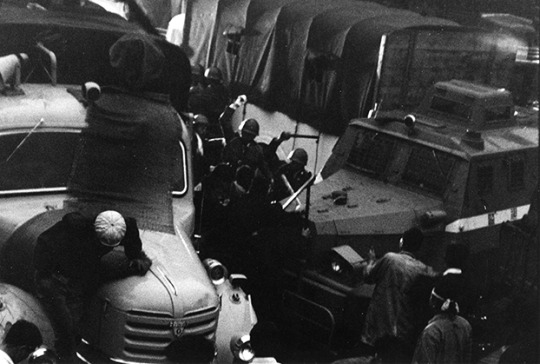



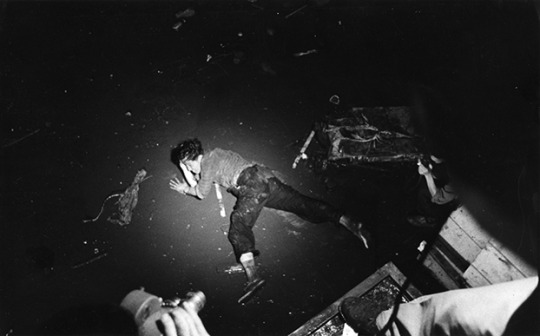

#Jun.15.1960#Anpo protests#June 15th Incident#安保闘争#Japanese Houses of Parliament#60年安保#history today
2 notes
·
View notes
Text
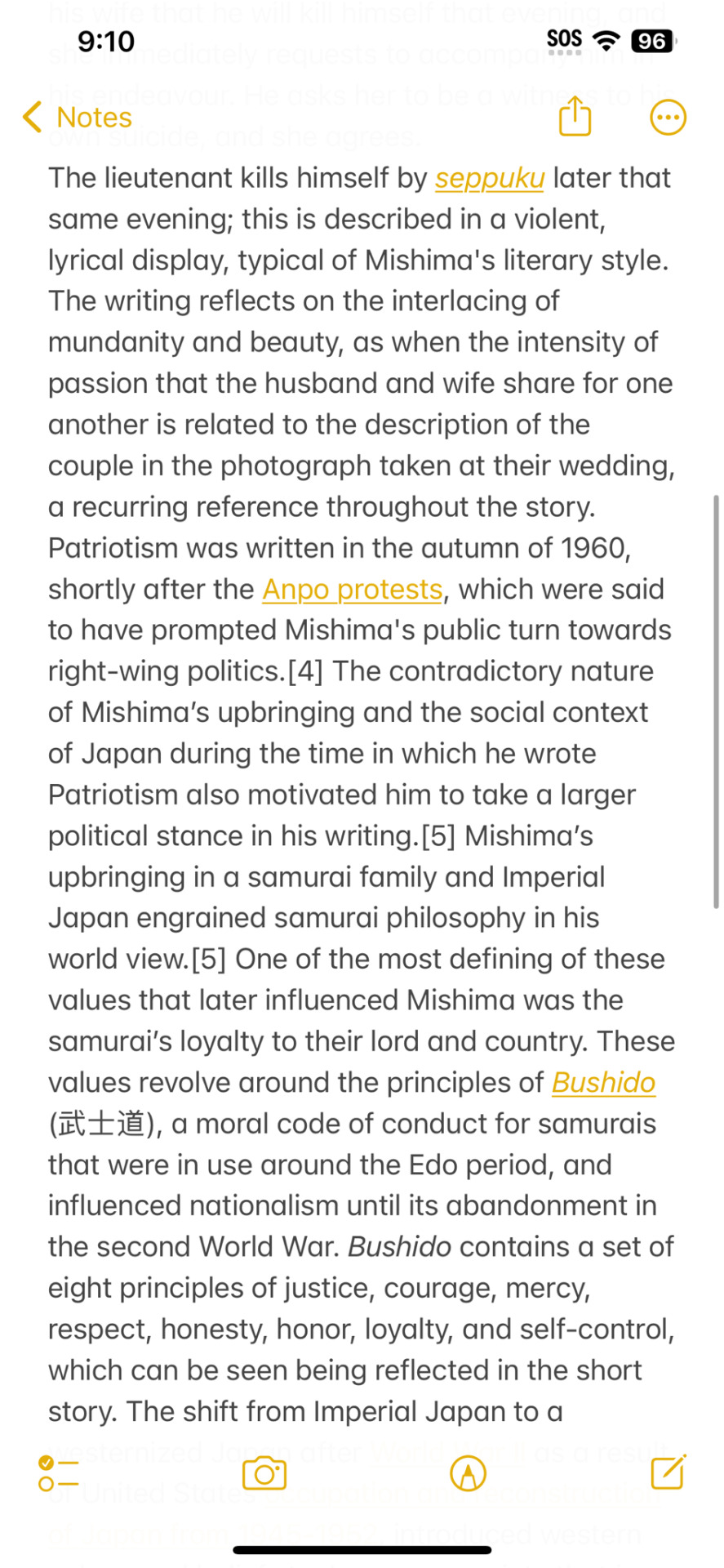
The lieutenant kills himself by seppuku later that same evening; this is described in a violent, lyrical display, typical of Mishima's literary style.
The writing reflects on the interlacing of mundanity and beauty, as when the intensity of passion that the husband and wife share for one another is related to the description of the couple in the photograph taken at their wedding, a recurring reference throughout the story.
Patriotism was written in the autumn of 1960, shortly after the Anpo protests, which were said to have prompted Mishima's public turn towards right-wing politics. [4] The contradictory nature of Mishima's upbringing and the social context of Japan during the time in which he wrote Patriotism also motivated him to take a larger political stance in his writing. [5] Mishima's upbringing in a samurai family and Imperial Japan engrained samurai philosophy in his world view. [5] One of the most defining of these values that later influenced Mishima was the samurai's loyalty to their lord and country. These values revolve around the principles of Bushido (It #i), a moral code of conduct for samurais that were in use around the do period, and influenced nationalism until its abandonment in the second World War. Bushido contains a set of eight principles of justice, courage, mercy, respect, honesty, honor, loyalty, and self-control, which can be seen being reflected in the short story. The shift from Imperial Japan to as CLONES
1 note
·
View note
Text
MRA and the politics of reconciliation
Excerpted from "The conservative imaginary: moral re-armament and the internationalism of the Japanese right, 1945–1962" by Reto Hofmann
Although now largely forgotten, during its heyday in the 1950s, MRA attracted prominent politicians, union leaders, and industrialists from all over the world.4 The movement had its roots in a Pennsylvania revivalist sect founded in the 1910s by the evangelist preacher Frank Buchman, who expanded it into an international movement in the 1930s, bringing it to the apex of its global popularity in the two decades after the Second World War. In those years, MRA brought together the German Chancellor, Konrad Adenauer, and the French Foreign Minister and founding father of the European Union, Robert Schuman (Luttwak 1995). It also involved prominent Asian politicians, such as Burma’s Unu and the President of the Philippines, Magsaysay, as well as the former Socialist Japanese Prime Minister, Katayama Tetsu. MRA formed a space for social and international debate that crossed party lines. To answer the question of why hardened conservatives such as Nakasone, Hatoyama, and Kishi reached out to it, requires briefly examining the organization of this movement and its ideology.
The generalized interest in MRA stemmed from its message about moral reconciliation and Buchman’s means to achieve it through an unofficial diplomacy based on a wide global network of actors and centres. Buchman’s teachings were based on his so-called Four Moral Absolutes – absolute honesty, absolute purity, absolute unselfishness, and absolute love – the application of which would bring about harmony. While initially Buchman focused on the internal harmony of the individual (MRA was the parent organization of Alcoholics Anonymous), he extended this message to include social harmony: if labour and management set aside their differences, a harmonious workplace could be reached and, as a result, social conflict eliminated. After the Second World War, Buchman was emboldened enough to promote what he now called MRA’s ‘ideology’ on the international arena. The war had left open wounds among nations, and MRA would provide a forum for leaders to reconcile with each other – this was the rationale for MRA’s championing Franco-German rapprochement through meetings between Adenauer and Schumann. To promote these encounters, MRA set up centres around the world, the most important of which were in Caux (Switzerland), Mackinack (United States), and Odawara (Japan) (Sack 2009, 53).
Although Buchman boasted about making MRA into a ‘spiritual force that is powerful enough to remake the world’, this movement has largely been studied through its American angle.5 To be sure, MRA’s American roots ran deep and, as demonstrated by Sack, Buchman drew heavily from Pennsylvanian evangelical traditions and retained a strong presence in the United States. Chelsea Szendi Schieder has shown that for MRA activists in Japan the United States remained a key point of reference: one of the movement’s key ways of promoting itself were theatre plays, and MRA used a Japanese play, The Tiger, to shape the American understanding of Japan at the time of the ANPO protests (Szendi-Schieder 2016). But the American connection did not figure as prominently for all those who became involved, and the way in which players on the ground appropriated MRA for a wider set of goals remains to be studied.6 In Japan, for example, a core group of MRA activists had come to the movement through their Christian background and, often, had visited the United States. The case of Nakasone, Hatoyama, and Kishi, however, differs. With the exception of Hatoyama, who was a Baptist, they were not Christians and lacked a significant prewar experience in the United States (this was also true of Hatoyama). Their turn to MRA, therefore, falls at least partly outside US–Japan relations.
The 1950s was a decade marked by political instability, a time of high levels of conflict over the course that Japan would take after it had regained nominal independence from the United States in 1952 (Kapur 2018). Conservatives – Nakasone, Hatoyama, and Kishi among them – recast themselves as agents of order and stability, a goal that required settling internecine disputes, forging new alliances, and gaining the trust of Japanese and their Asian neighbours alike. It was in this sense that MRA’s politics of reconciliation struck a chord. It offered a rhetoric of social and international harmony and, at the same time, an international network that, crucially, transcended the United States. This latter aspect appealed to Nakasone, Hatoyama, and Kishi, because they were highly critical of the alliance with Washington, which, they considered, unduly subordinated Japan to the superpower’s whims. They aspired to a new politics of conservatism that would pave the way for Japan to liberate itself from the American embrace. MRA, which was compatible with the American world order but did not take orders from Washington, was an avenue for these three figures to chart a conservative agenda that was relatively autonomous from the United States by virtue of being able to interact directly with ideas and leaders from the wider Cold War world. It was, at the same time, an opportunity to reconcile their politics, which presented marked prewar features, to the exigencies of the 1950s as a precondition to participate in the Cold War. In so doing, the encounter between these towering postwar politicians and MRA sheds light on three important aspects of postwar conservatism: its relationship to nationalism, social harmony, and visions of Asian regionalism.
#mra#Moral Re-Armament#moral re-armament movement#reconciliation#ideology#cold war#anti-communism#kishi#nobusuke kishi#japanese politics#politics#religion#frank buchman#oxford group#right-wing politics#history#japanese history
0 notes
Note
hi there Ash! after the recent posts about the 60s-70s leftist background of Miyazaki, Takahata and Oshii, which pulled in some specific details new to me... I was wondering if also you happened to know anything about the background of Hiroyuki Okiura as well?
i wonder mostly based on the different spin he put on Oshii's Kerberos franchise in Jin-Roh - Oshii wrote the script but the film has a very different emotional tenor to his live action films and even the manga. but it's quite hard to find a lot of sources on Okiura's life in English outside of the films he worked on!
('course for all I know it might just be all "put nose to the grindstone and animated intensely from age 5" lol, there's no reason there has to be a story like "the protest scene in jin-roh draws on xyz real experience")
I don't know too much about Okiura, honestly - but that maybe isn't my fault, he is I believe not an interview guy, and is not one to go off-the-cuff on any and all topics at a moment's notice (a requirement for being a member of 1968 Kids club). Still, from what I know I would definitely not slot him into that category?
Trivially, he was born in 1966 - too late for the gen. More substantially, he is one of those guys who is just obsessed with the craft of animation - reading any and all manga as a kid, dropping out of highschool at age 16 to work at Anime Earl, not really going to college or having any other kind of exposures that would radicalize someone of that era. Every interview I see with Okiura is one like this; extremely detailed discussion of animation frame rates, cut counts, color choices, reference material, etc; even the plots of the projects he has worked on don't come up very much, let alone the themes.
I think realism is absolutely an obession of his - if you did the opening of Knocking on Heaven's Door it sort of has to be - and that realism is what made him so good on project's like Oshii's, key animation on Akira, yadda yadda. But I view that as an artistic obsession, the aesthetics of realism and grit and all that. Obviously he may just be very private about his politics, and I am not saying he like doesn't 'understand' these things, of course he does. I just don't see any indication that its a passion of his. I view him as card carrying member of the 80's "apolitical otaku" that grew in popularity at the time, and probably one of the more prominent members of that diffuse group. Real "Simulacra vs the Database" vibes, he is that second gen where anime exists for its own purpose.
And I think that commitment shines through in his work- his realism is very focused on the humanity of the subject, its a 'camera' devoid of judgement if that makes sense. It works just as well in Jin-Roh as in say Your Name for that reason.
Though funnily enough his uncle is Okiura Kazuteru, a Japanese marxist sociologist whose career was spent documenting the ethinc minorities of Japan and advocating against discrimination, and when he was at University of Tokyo in the late 50's was a member of the Communist Party and possibly, debately, tried to assassinate a journalist? He is absolutely one of the Anpo Generation, so it is in the blood!
...also when looking up interviews I did find the opening quote from an interviewer: "Hiroyuki Okiura is a thigh man". I take it all back, this is the only politics that matters in the end.
15 notes
·
View notes
Link
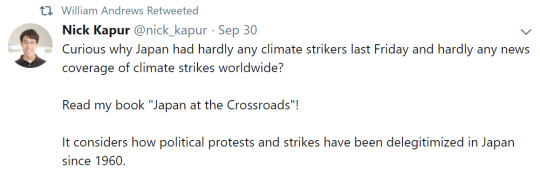
Image text: “Curious why Japan had hardly any climate strikers last Friday and hardly any news coverage of climate strikes worldwide? Read my book "Japan at the Crossroads"! It considers how political protests and strikes have been delegitimized in Japan since 1960.”
#Anpo protests#japan#social activism#political activism#japanese politics#social justice#reading list#research
0 notes